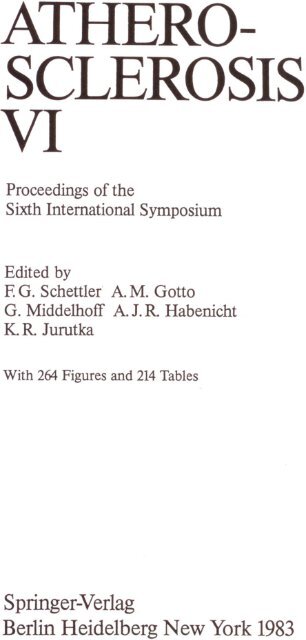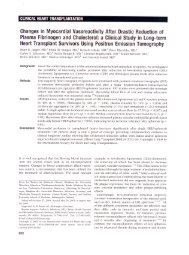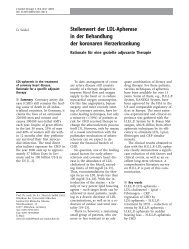Springer-Verlag Berlin Heidelberg New York 1983
Springer-Verlag Berlin Heidelberg New York 1983
Springer-Verlag Berlin Heidelberg New York 1983
- No tags were found...
Create successful ePaper yourself
Turn your PDF publications into a flip-book with our unique Google optimized e-Paper software.
<strong>Springer</strong>-<strong>Verlag</strong><strong>Berlin</strong> <strong>Heidelberg</strong> N ew <strong>York</strong> <strong>1983</strong>ATHEROCLEROSIVIProceedings of theSixth International SymposiumEdited byE G. Schettlet A. M. GottoG. MiddelhotT A. J. R HabenichtKR JurutkaWith 264 Figures and 214 Tables
Measurement of 125 I-activity in various organs after the administrationQ~ 1251 LP-X shows that most of the radioactivity is found in the spleen.When rats were injected with 125 I LP-X, the amount of radioactivityfound in the spleen was 7-fold greater on a 9 wet weight basis than thatfo~ndin liver at 60 min.after injection (Fig. 2). Measurement cf theradioactivity at various time intervals shows that this high activityin spleen was maintained even 24 h after injection of 125 I LP-X. Asmall amount of radioactivity was found ~n ether organs, such as pan-586MethodsIsolation and Labelling of LP-XIn order to establish the site of LP-X uptake, LP-X was isolated fromhuman bile by a combination of ultracentrifugation and Cohn fractionation(6). After checking its purity by chemical, electrophoretic andimmunochemical analysis, it was iodinated in the albumin moiety with125i:Iodineby the standard iodination technique. It was then dialyzedand recentrifugated for 20 hours at d 1.065 g/ml to remove any tracesof free iodine and albumin. Before use the preparation was again dialyzedand checked for purity.Liver Perfusion TechniqueLivers were perfused after isolation with Krebs-Ringer-bicarbonatebuffer containing 2.5% albumin and 10% hemoglobin in the form of humanerythrocytes in a recirculating system.IsolatedHepatocytesHepatocytes were prepared by the technique of collagenase perfusion.They were incubated in Krebs-Ringer-bicarbonate buffer containing 4%albumin at 37oC.IsolatedLymphocytesLymphocytes were isolated from heparinized blood over lymphoprep gradient.They were then incubated in RPMI medium containing 10% foetalcalf serum. After 2 hours of incubation unattached cells were incubatedin the fresh medium.FibroblastsFibroblasts derived from normal subjects were maintained in Dulbecco'sminimal essential medium with 25 mM NaHC03' 20 mM Hepes buffer, pH 7.4and 10% foetal calf serum. Cultures between 5 to 10 passages were usedfor experiments.Results and DiscussionClearance of LP-X from PlasmaFor in vive experiments rats were anaesthatized with Evipan natrium and1 ml 125 I LP-X (about 2-3 mg free cholesterol) was injected into thesaphenous vein. As seen in Fig. 1 LP-X disappears very rapidly fram thecirculation. The disappearance of 125 I LP-X is similar to the longterm decay curve obtained in rats which have been injected with unlabelIedLP-X. (1)Uptake of LP-X in v~vo, in Isolated Perfused Livers, Isolated Hepatocytes,Lymphocytes and Monolayer Cultures of Fibroblasts
-~ votues hom literature (SeIdel el.al 1976)30u587'" a...:D 8eu)(, 0C••5a. ~200 i5::; Q. .!ö ~• 1251_act,voty I means: 5"EM 01 3an'rn
Fiq. ~Binding and uptake of LP-X by isolated hepacytes, lymphocytes andmonolayer cultures of fibroblasts. Cells were incubated with ~25I LP-X( 1.4Bx104 cpm/~g LP-X protein) and unlabelled LP-X. Incubations werecarried out at 37°C for 120 min588creas, kidney, lung, he art and muscles. In contrast, after injectionof 125 I-albumin a small but equal amount of radioactivity was foundin the liver and spleen. These results clearly show that in rats LP-Xis mainly taken up the spleen and that the amount of LP-X removed fromthe circulation by the liver is only a small fraction of that removed bythe spleen. Experiments with isolated perfused livers showed that when125 I LP-X is added to the perfusion medium, it is removed by the liverto only a small extent, but within minutes. However when hepatocyteswere isolated from these perfused livers, it was observed that onlya small percentage of the 1251 activity found in the liver was presentin parenchymal cells. Instead it was mainly present in the non-parenchymalcells. These in vitro experiments substantiate the results ofthe in vivo experimen~s, showing that the spleen and non-parenchymal11ver cells remove LP-X from the circulation.The bindlng and uptake of 125 I LP-X by lymphocytes, fibroblasts andhepatocytes was concentration dependent but did not reach saturationkinetics (Fig. 3). Hepatocytes and fibroblasts bound only a smallfraction of the amount bound by lymphocytes. This again stresses thelmportance of non-hepatic cells such as lymphocytes in the removal ofLP-X.3000Lymphocyt•• I LP-x .125 I-LP-x )Lymphocyles I 125( - LP-x )Hepalocyles I LP-x •1251_LP_x)Skin Fibroblasls (LP-x • 1251_LP_xIo~ 2000Ö~•• ...c:0;;ÖI!.1000~ ..JCIc:w ~ W ~LP-x (llg protein/ml incubatoanmedium)
--H . ._n _It is weIl established that hepatic tissue almost completely removeschylomicron remnants from the circulation. In the presence of LP-X inthe perfusion medium the removal of 14C cholesteryl oleate labeliedremnants was significantly reduced (about 50% of control). The livertissue also had about 50% of the 14 C-activity as compared to cOQtrols.Similarly isolated hepatocytes bound about 50% of the 14 C-labelledremnants, as compared to those without LP-X. Thus both the reduced uptakeof remnants and probably leaching of cellular cholesterol due tothe high phospholipid content of LP-X may playamajor role in enhancedcholesterol synthesis in cholestatic liver and result in hypercholesterolemia.589LP-X and HMG-CoA reductase activityParallel to the binding or uptake of LP-X by lymphocytes, suppression ofthe activity of HMG-CoA reductase similar to that with LDL was noted inthese cells. Lymphocytes isolated from the blood of cholestatic patientsalso contained very low activity of HMG-CoA reductase as compared to con,trols (0-11.5 pmol as compared to 55 pmol/mg protein/h). However additionof LP-X to the perfusion medium caused a 5-fold increase in theactivity of HMG-CoA reductase in microsomes of these livers (Fig. 4).An increase in the activity of the enzyme was also no ted in microsomesof hepatocytes incubated with LP-X. In vitro incubation of isolatedhepatic microsomes with LP-X resulted in the suppression of the enzymeactivity in a concentration dependent manner. This increase in the ac tivityof HMG-CoA reductase by LP-X is not specific for hepatic tissue.Inclusion of LP-X in media of monolayer cultures of fibroblasts, eitherin the presence of foetal calf serum or lipoprotein deficient serum,increases the activity of the reductase. These da ta suggest that inthose cells which poorly bind or take up LP-X, a leaching of cellularcholesterol might occur.o min.'" ?: "C '00 500gu:> 300 100 200~ (!) ••• e!
1. Seidel D, Buff HU, Fauser U, Bleyl U (1976) On the metabolism oflipoprotein-X. Clin.Chim.Acta 66:195-2072. Liersch M, Baggio G, Heuck ce, Seidel D (1977) Effect of lipoproteinX on hepatic cholesterol synthesis. Atherosclerosis 26: 505-5143. Kattermann R, Creutzfeldt W (1970) The effect of experimental cholestasison the negative feed-back regulation of cholesterol synthesisin rat liver. Scand J Gastroenterol 5: 337-3424. Weis JH, Dietschy JM (1971) presence of an intact cholesterol feedback mechanism in the liver in biliary stasis. Gastroenterology 61:77-845. Cooper AD, Ockner RK (1974) Studies of hepatic cholesterol synthesisin experimental acute biliary obstruction. Gastroenterology 66: 5865956. Manzato E, Fellin R, Baggio G, Walch S, Neubeck W, Seidel D (1976)Formation of lipoprotein-X, its relation to bile compounds. J. clin.Invest. 57: 1248-1260590The pathobiochemical features of cholestatic hypercholesterolemia maybe summarized as follows:1. Phvsicochemical conversion of biliary lipid micelles into the LP-Xvesicle after reflux of bile into the plasma.2. Disturbed triglyceride hydrolysis of plasma lipoproteins throughunphysiological apoprotein binding on the LP-X vesicle.3. Disturbed enterohepatic circulation of bile acids and cholesterol.4. Lack of inhibition of hepatic cholesterol biosynthesis by chylomicronremnants in the presence of LP-X.5. Inability of liver to take up cholesterol in the form of LP-X.6. Leaching of hepatic cellular choles~erol by LP-X, possibly becauseof its high ratio of phospholipid to cholesterol.AcknowledgementsThis study was supported by the Deutsche Forschungsgemeinschaft ( S FB89, Cardiology - D 3400 G6ttingen FRG).We are thankful to Miss Christina Wiese and Miss Sylvia Kumm for excellenttechnical assistance.References






